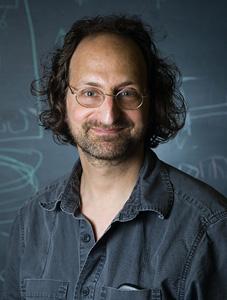August 19, 2008
Caroline Jenkins Hanna
Director of Media Relations
413/542-8417
AMHERST, Mass. – Nature, one of the world’s leading academic journals, has recognized the 1996 research of Amherst College physics professor Jonathan Friedman as a major scientific development in spin physics. Friedman’s work exploring mesoscopic spin systems was noted in the publication’s “Milestones in Spin” supplement, highlighting the most influential discoveries in the field since 1896.
 Physics Professor Jonathan Friedman |
“Naturally, I was delighted to see my work lauded in this way,” said Friedman, who continues to do research in the field at Amherst. “When my colleagues and I made the discovery of tunneling between spin states in these single-molecule magnets, I knew it was important work, but I would not have foreseen that it would ignite an entire research field. That’s been phenomenal.” The field of single-molecule magnets (each molecule behaving like a tiny magnet) now involves hundreds of researchers around the world and more than 1000 papers have been published in the field.
In “Milestones in Spin,” editors with the London-based Nature Publishing Group covered what they considered to be breakthrough developments in spin in 23 short “Milestone” articles. (Spin is the intrinsic angular momentum of elementary particles that gives rise to their magnetism and, by extension, the magnetism of many materials.) The pieces discuss landmark discoveries in the context of the prevailing concepts at the time they were made as well as scientists’ current knowledge of the field. Friedman’s research is mentioned in Milestone 22, which deals with the mesoscopic tunneling of magnetism.
“The year 1996 saw the publication, by Jonathan Friedman et al. and Luc Thomas et al., of what many consider to be the definitive proof that mesoscopic spin systems … can undergo quantum-mechanical tunneling of their total magnetization,” the Nature piece reads. “These experiments revealed transitions between bulk magnetic states that were not driven by thermal fluctuations, as one would expect classically; instead, they corresponded unambiguously to quantum-mechanical tunneling events between different collective spin states of the whole system that have been brought into resonance by an applied magnetic field.”
Tunneling, according to Friedman, is a uniquely quantum phenomenon in which a system—a particle, for example—can traverse an energy barrier without having enough energy to overcome it. When such an event occurs, the system is said to have “tunneled through” the barrier. Friedman’s work was the first to show definitively that a magnet could reverse direction from pointing up to down by tunneling.
Friedman earned a bachelor of arts degree from Vassar College and his doctorate in physics from the City University of New York. He joined the Amherst faculty in 2001 after several years working at Stony Brook University. In 2002, Friedman shared the Agilent Technologies Europhysics Prize, one of the most prestigious physics prizes awarded by the European Physical Society, for his work in this field.
In addition to the articles, “Milestones in Spin” includes a timeline—a chronology of the earliest papers connected with each Milestone—and a reprinted collection of relevant articles and reviews from Nature, Nature Materials, Nature Physics and Nature Structural Biology. The “Milestones”article on Friedman’s work can be found at www.nature.com/milestones/milespin/full/milespin22.html. For more on Friedman, go to www.amherst.edu/~jrfriedman.